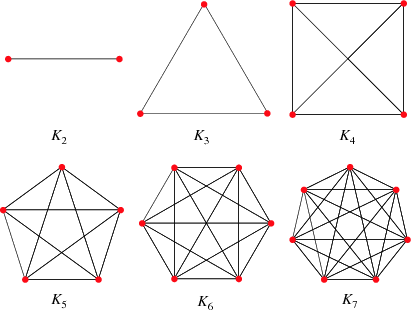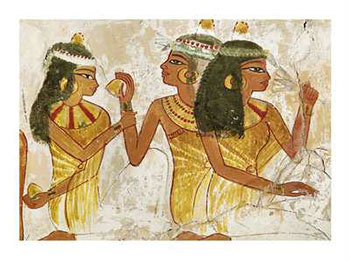- You have a homework due today.
- You have a homework due Thursday.
- You have a homework due Tuesday of next week.
Keep up with your homework!
- The triangle has been studied for quite some time before the time of Pascal
- Contains
- Powers of 2
- natural numbers
- triangular numbers ($\frac{n(n+1)}{2}$ for $n$ an natural number)
- Even tetrahedral numbers (and beyond)!
- Fibonacci numbers
- Was used for
- binomial coefficients
- Was used for counting. We were looking at
simple graphs, which I presented in the context of Facebook. A
simple graph is made up of
- vertices (or points, which we will think of as people), and
- edges (which are also called arcs, connecting two points -- which we will think of as friendships). Note that there is at most one arc between two friends. There's no such thing as multiple friendships with one person.
Now, if we don't care about "who's who", then we can see all the different types of Facebooks we can have:
- Let's look at some simple cases: 2 or 3 individuals
- All simple graphs with four vertices.
- All simple graphs with five vertices.
- Now, if we add names to the "vertices", then we have more
Facebooks. If everyone's friends with everyone else, then the graphs we
can get will look like these (called complete -- very
social! -- graphs):

Now how many different Facebook configurations are there for, say
- 2 individuals?
- 3 individuals?
- 4 individuals?
- The upshot is that a row of Pascal's triangle tells us
how many different ways we can choose a certain number $p$ of
objects from amongst $n$. This is why it was so useful to
Pascal in his gambling exercises....
- In the case of Facebook, we're looking at setting up friendships, which are relationships between n people. So we look to the row containing the number of friendships possible between $n$ people, which is the triangular number $\frac{n(n+1)}{2}$. That row tells us how many different Facebooks we can have with any given number of friendships.
- Now, for our Fibonacci spiral contest!
Anyone who would like to be in the contest should put their spiral up front. Then we'll vote.
- Now, on to the Egyptians (let's do math like the Egyptians!):

- Let's start with a look at the history of a western understanding of Egyptian Mathematics.
- At the heart of Egyptian multiplication is the "Fraudini fact", or the "binary factorization":
Every natural number is either a power of two, or can be expressed as a sum of distinct powers of two in a unique way. (I underline "distinct" because you cannot repeat powers: otherwise you could write, for example,
3=1+1+1 rather than3=2+1 (which is the unique binary factorization). - Again this is parallel to our two other factorizations:
- The prime factorization (which you encountered somewhere along the
line in your elementary education):
Every natural number (other than 1) is either prime, or can be expressed as a product of prime numbers in a unique way. - The Fibonacci factorization:
Every natural number is either Fibonacci, or can be expressed as a sum of non-consecutive Fibonacci numbers in a unique way.
- The prime factorization (which you encountered somewhere along the
line in your elementary education):
- We'll start with a simple example: multiply 23*42.
- Let's show that we can do a multiplication in either
order, by checking the product 42*23.
- Let's try a longer multiplication. Consider, for example, 321*112:
1 321 2 4 8 16 32 64 128 Too big! Now add up those rows marked with an asterix (*), and you'll get the answer (35952).
- Examples: Try these:
- 43*16
- 21*79
- Now: multiplication's not too bad. How about Egyptian division?
- fractions -- binary decimals, oh Ra!
- First of all, division is just multiplication backwards, right?
Let's look at the simplest example imaginable: divide 32 by 8. We can actually do it by Egyptian multiplication, since 8 divides into 32 evenly:
1 8 2 16 4 32 * So the answer is 4 (how do we get 4?)
- Similarly we could divide 40 by 8, using the same
table (again easy, since 8 divides into 40 evenly):
1 8 * 2 16 4 32 * So the answer is 5 (how do we get 5?)
- When the denominator doesn't divide the numerator
evenly, fractions make it more interesting:
Let's look at an example: divide 35 by 8.
In a way we turn it into a multiplication problem: what times 8 equals 35? So we know the 8, and use it to "double" -- but then to "halve", when 8 won't go evenly into 35:
1 8 2 16 4 32 * 1/2 4 1/4 2 * 1/8 1 * So the answer is 4+1/4+1/8
(Where have we seen those fractions before? Look to the Eye of Horus!)
- the Egyptians restricted
themselves to the so-called "unit fractions", which are
fractions of the form 1/m:
unit
fraction table, which is found on the Rhind
Papyrus (which dates to around 1650 BCE).
But they didn't restrict themselves to "halving", as our next example shows. Divide 6 by 7:
1 7 1/2 3+1/2 * 1/4 1+1/2+1/4 * 1/7 1 1/14 1/2 * 1/28 1/4 * So the answer is 1/2+1/4+1/14+1/28
- Why did
Egyptians do things this way? (an example division problem, using binary)
Dominic Olivastro, "Ancient Puzzles", suggests a third reason why this use of unary fractions is good. Consider the problem Ahmes poses of dividing 3 loaves of bread between 5 people. We would answer "each person gets 3/5-ths of a loaf". If we implemented our solution, we might then cut 2 loaves into 3/5 | 2/5 pieces, with bread for 3 people; then cut one of the smaller pieces in half, giving the other two people 2/5 + 1/5 pieces. Mathematically acceptable, but try this with kids and they will insist that it is not an even division. Some have larger pieces, some have smaller. Ahmes would calculate 3/5 as : 3/5 = ()3 + ()5 + ()15 [ = 1/3 + 1/5 + 1/15 ] Now cut one loaf into fifths, cut two more into thirds, then take one of the 1/3-rd pieces and cut it into 5-ths (for the 1/15-th pieces), and you can now distribute everyone's 3/5-ths share in a way that _looks_ equal, since they will have exactly the same size pieces. (And no, I don't want to argue about the crust.)
- Here's a relatively easy one: Suppose Fatima had 3
loaves to share between 4 people. How would she do it?
(Think about what the answer means, in terms of bread.)
- A little trickier:
- How would you divide 5 by 7?
- How can we use the unit fraction table to get the same answer?
- How would you like to do story problems like this one?!
- fractions -- binary decimals, oh Ra!
- Let's start with a look at the history of a western understanding of Egyptian Mathematics.